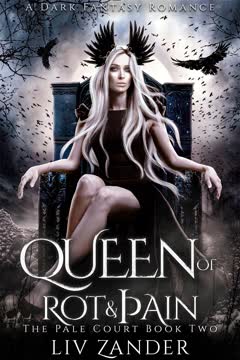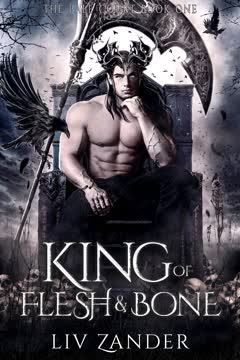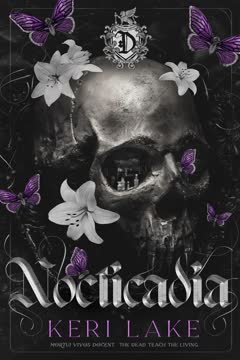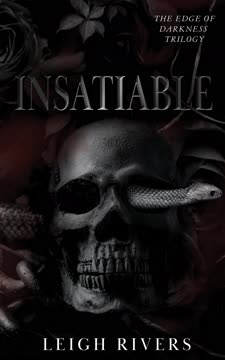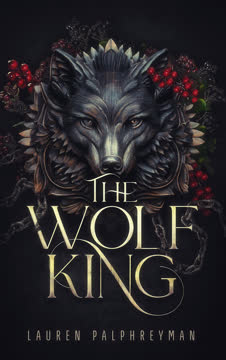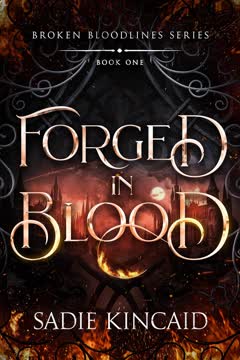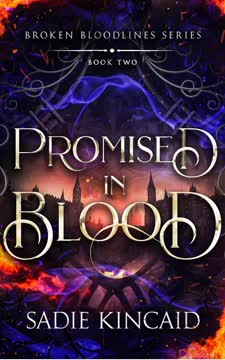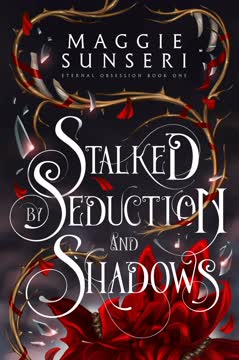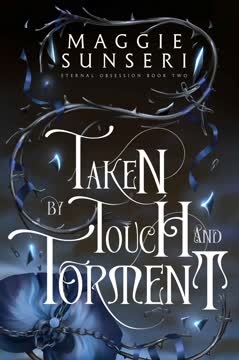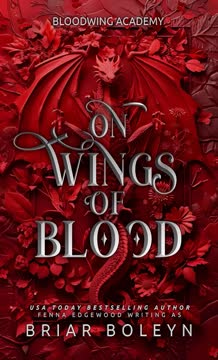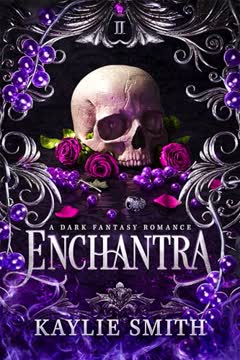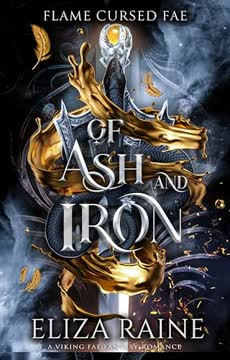Plot Summary
Chains and Collars Broken
Ada, a mortal woman, is thrust into the Pale Court, a crumbling kingdom ruled by Enosh, the god of rot and bone. Chained by a collar of bone, Ada's initial existence is one of resistance and survival, her only goal to escape and honor her late husband's grave. Enosh, wounded by centuries of betrayal and loss, finds himself both tormented and fascinated by Ada's defiance. Their relationship is fraught with power struggles, as Ada's humanity and stubbornness challenge Enosh's godly detachment. The chains that bind her are both literal and emotional, setting the stage for a story where captivity, longing, and the search for agency intertwine. The coldness of the Pale Court mirrors the emotional distance between them, but beneath the surface, a dangerous intimacy begins to grow.
Death's Cold Embrace
After a brutal attack by villagers who fear she carries the god's child, Ada is stabbed and dies. Her soul is caught between worlds, drifting in the Court Between Thoughts, a surreal realm ruled by Enosh's brother, Yarin. Here, Ada confronts the horror of her own death and the loss of her unborn child, while Enosh, scarred and vengeful from his own recent torture, claims her soul. The coldness of death is both physical and existential, as Ada is forced to reckon with her new state—neither fully alive nor at peace. Enosh's rage at her perceived betrayal is matched only by Ada's grief, and their reunion is a collision of pain, accusation, and desperate longing. Death and resurrection becomes Ada's new collar, binding her to Enosh and the Pale Court for eternity.
The Court Between Thoughts
In the liminal space of Yarin's court, Ada's soul is bartered for corpses, and she glimpses the madness and power of the gods. The surreal, decadent court is a place of both temptation and terror, where Ada's memories blur and her sense of self is tested. Yarin's whispers and Enosh's possessiveness threaten to unravel her, but Ada's will endures. The gods' games reveal the depth of their wounds and the complexity of their relationships, especially the ancient betrayals that haunt Enosh. Ada's journey through the Court Between Thoughts is a crucible, forging her resolve to reclaim agency—even in death.
Rot, Pain, and Betrayal
Back in the Pale Court, Ada and Enosh are locked in a cycle of accusation and misunderstanding. Enosh, convinced Ada has betrayed him with another man and lied about her pregnancy, inflicts both emotional and physical punishment. Ada, desperate to explain, is silenced and shamed, her grief over the lost child dismissed as deception. The court itself becomes a reflection of their pain, with rot and decay spreading as trust erodes. The wounds between them are raw, and the threat of eternal punishment looms. Yet, beneath the cruelty, a longing for connection persists, hinting at the possibility of forgiveness.
The God's Wrath Unleashed
Enosh's rage at Ada's supposed betrayal manifests in acts of violence and domination. He punishes her with coldness, denial, and humiliation, refusing her warmth and affection. Ada, trapped in a body that no longer lives, is tormented by longing and isolation. The Pale Court becomes a mausoleum of suffering, with Ada's crown of bone and entourage of child corpses serving as constant reminders of her failures. Enosh's wrath is both a weapon and a shield, protecting him from vulnerability but also deepening his own agony. Their relationship teeters on the edge of destruction, with pain as both punishment and proof of love.
Hunger, Grief, and Ghosts
Isolated and haunted by loss, Ada seeks solace in the Pale Court's decaying halls. She confronts Orlaigh, the god's ancient servant, and uncovers secrets about the past—especially the tragic story of Njala, Enosh's former lover, and her forbidden child. Ada's hunger is both literal and metaphorical, a yearning for warmth, meaning, and forgiveness. The ghosts of the past press in, and Ada's own sense of self wavers between victim and survivor. Her journey becomes one of piecing together the truth, not just about Enosh and the gods, but about her own worth and desires.
The Mask of Cruelty
The mask Enosh wears—of cruelty, arrogance, and divine detachment—begins to crack. Ada's defiance, her refusal to submit or be broken, forces Enosh to confront his own pain and longing. Their interactions oscillate between violence and tenderness, punishment and plea. Ada's attempts to reach the man beneath the god are met with both resistance and reluctant openness. The emotional stakes rise as both are forced to reckon with the cost of their masks, and the possibility of something more honest and human between them.
The Queen's Crown of Bone
In a twisted act of both punishment and recognition, Enosh crowns Ada with a circlet of children's bones, making her the Queen of Rot and Pain. The Pale Court is transformed, rebuilt from the remains of the dead, and Ada is given dominion—but at a terrible price. The victory is hollow, as the crown is a symbol of both her power and her suffering. Ada's new role is both a cage and a throne, and the emotional cost of her ascent is profound. The court's beauty is matched only by its horror, and Ada's reign begins in mourning.
Secrets of the Dead
Ada delves into the mysteries of the Pale Court, questioning the corpses woven into Enosh's throne and uncovering the truth about Njala's child. The revelation that the child was not Enosh's, but the product of a forbidden love, shatters centuries of grief and blame. Ada's own sense of guilt and hope is reignited, as she wonders if she, too, might carry a child—one that even the gods cannot sense. The secrets of the dead become the key to understanding the living, and Ada's quest for truth becomes a quest for redemption.
The Price of Vengeance
As Enosh unleashes his vengeance on the world, Ada is forced to confront the cost of revenge. The gods' power is immense, but so is the suffering they inflict. Ada bargains with Eilam, the god of life, for the chance to be restored and to save her unborn child. The price is steep: blood for blood, and the abandonment of mercy. Ada's compassion is tested, and she must choose between her own happiness and the lives of others. The world is remade in violence, and the line between justice and cruelty blurs.
The Grave and the Heart
In a moment of ultimate punishment, Enosh buries Ada alive, forcing her to confront the depths of her fear and the limits of his own cruelty. The grave becomes a crucible, burning away the last remnants of pride and pretense. When Enosh cannot bring himself to finish the act, the possibility of forgiveness emerges. Their reconciliation is raw and hard-won, built on mutual confession and the recognition of shared pain. The grave is both an ending and a beginning, a place where love and hate are indistinguishable.
Forgiveness and Fury
Ada and Enosh, battered by suffering and loss, find a fragile peace. Enosh confesses his love, and Ada, in turn, acknowledges her own feelings. Their union is renewed, not as god and captive, but as equals bound by pain and hope. The promise of a child, and the possibility of a new beginning, offer a path forward. Yet, the world outside remains hostile, and the cost of their happiness is not yet paid. Forgiveness is a daily act, and fury is never far from the surface.
The Child That Wasn't
The question of Ada's child—whether it ever existed, whether it can be saved—becomes the emotional fulcrum of the story. The gods' inability to sense the child, and the revelation of Njala's mortal offspring, cast doubt and hope in equal measure. Ada's longing for motherhood is both a source of strength and vulnerability, and Enosh's desire for a family is revealed as the heart of his pain. The truth, when it comes, is both devastating and redemptive, forcing both to confront what they truly want from each other and the world.
The Court of Brothers
The three brothers—Enosh, Yarin, and Eilam—are drawn into a final confrontation over Ada's fate. The gods' rivalries and wounds are laid bare, and Ada's restoration becomes a matter of cosmic negotiation. The price of life is vengeance, and the gods' power is both a blessing and a curse. Ada's agency is tested as she must prove her willingness to do what is necessary, even as the gods' games threaten to consume her. The court of brothers is a place of both judgment and possibility.
The Bargain for Life
In a climactic act, Ada bargains for her life and the life of her child, agreeing to pay the price in blood and abandon mercy. Eilam, the god of life, restores her, but the process is fraught with danger and uncertainty. Ada emerges not as a mortal, but as something new—a goddess in her own right, with the power to command the dead and shape the world. The transformation is both a victory and a burden, as Ada must learn to wield her new power and accept the consequences of her choices.
Becoming the Queen
As the Queen of Rot and Pain, Ada embraces her role as both judge and executioner. She hunts down those who wronged her, enacts vengeance on the priests and soldiers of Helfa, and remakes the world in her image. The cost of justice is high, and Ada's compassion is tested at every turn. Yet, she finds strength in her love for Enosh and the promise of their child. The world is remade, not in mercy, but in the hard-won balance of pain and hope.
The Temple Burns
Ada infiltrates the high temple, confronts the high priest, and sets the world of Helfa ablaze. The temple's destruction is both literal and symbolic, marking the end of an age of false gods and the beginning of a new order. Ada's power is unleashed, and the world trembles at her command. The cost is great—pain, loss, and the scars of fire—but from the ashes, something new is born. The gods' reign is transformed, and Ada's place among them is secured.
The World Remade
In the aftermath of destruction, Ada and Enosh find a fragile peace. The world is remade, the Pale Court restored, and the promise of a child fulfilled. Parenthood brings new challenges and joys, as Ada and Enosh learn to balance power and tenderness, vengeance and mercy. The scars of the past remain, but the future is open. The world is not healed, but it is changed, and the legacy of rot and pain becomes the foundation for something enduring.
The Goddess and Her Child
The story closes with Ada and Enosh, now equals in power and love, raising their child in a world they have remade. The pain and rot of the past are not forgotten, but transformed into wisdom and strength. The gods' wounds are not healed, but they are shared, and the promise of eternity is no longer a curse, but a hope. The Queen of Rot and Pain is no longer a victim, but a creator, and her child is the symbol of a new beginning.
Characters
Ada
Ada begins as a mortal woman, marked by loss, guilt, and a fierce will to survive. Her journey is one of transformation—from captive to queen, from victim to agent, from mortal to goddess. Ada's relationships are defined by her resistance to domination and her longing for love and belonging. Her psychological arc is one of reclaiming agency, confronting trauma, and learning to wield power without losing compassion. Her love for Enosh is hard-won, forged in suffering and forgiveness, and her desire for a child becomes the emotional core of her story. Ada's development is a testament to resilience, as she learns to balance pain and hope, vengeance and mercy, and ultimately claims her place among the gods.
Enosh
Enosh is a god broken by centuries of betrayal, loss, and abandonment. His initial cruelty masks a deep vulnerability and longing for connection. Enosh's relationship with Ada is fraught with power struggles, as he oscillates between punishing her and yearning for her love. His psychological wounds are rooted in the loss of his former lover, Njala, and the child he believed was his. Enosh's arc is one of learning to trust, to forgive, and to accept love without domination. His transformation is mirrored in the restoration of the Pale Court and the birth of his child with Ada. Enosh's journey is a meditation on the cost of power, the pain of immortality, and the possibility of redemption.
Yarin
Yarin, Enosh's brother, rules the Court Between Thoughts—a realm of madness, temptation, and secrets. He is both trickster and confidant, manipulating thoughts and desires with ease. Yarin's relationship to Ada is ambiguous, oscillating between ally and adversary. Psychologically, Yarin is driven by curiosity, boredom, and a desire to disrupt the status quo. His interventions often force Ada and Enosh to confront uncomfortable truths, and his bargains are always double-edged. Yarin's development is less about change and more about revelation, as his true motives and wounds are gradually exposed.
Eilam
Eilam, the third brother, is the god of life's breath and its absence. He is detached, judgmental, and often at odds with his siblings. Eilam's relationship to Ada is marked by both fascination and disdain, as he is both the gatekeeper of her resurrection and the arbiter of her worth. Psychologically, Eilam is driven by a rigid sense of order and a deep discomfort with the chaos of emotion and mortality. His development is subtle, as he is forced to reckon with the consequences of his power and the limits of his detachment.
Orlaigh
Orlaigh is Enosh's soul-bound servant, a figure of both wisdom and duplicity. She is deeply loyal to the Pale Court but harbors secrets that shape the story's central mysteries—especially the truth about Njala and her child. Orlaigh's relationship to Ada is complex, oscillating between mentor, rival, and betrayer. Psychologically, Orlaigh is driven by survival, guilt, and a longing for rest. Her development is a cautionary tale about the cost of complicity and the burden of secrets.
Njala
Njala, though long dead, is a haunting presence in the story. Her forbidden love, her child, and her death are the wounds that shape Enosh's and Ada's fates. Njala's choices—her affair with Joah, her refusal to return to Enosh, her death—are acts of agency in a world that denies women power. Psychologically, Njala is both victim and rebel, her legacy a reminder of the cost of love and the dangers of secrets.
Joah (Commander Mertok)
Joah is the mortal commander who loved Njala and fathered her child. His loyalty to Lord Tarnem and his love for Njala are in constant conflict, culminating in tragedy. Joah's role is that of the doomed lover, his actions both heroic and heartbreaking. Psychologically, Joah is torn between duty and desire, his development a meditation on the limits of loyalty and the price of love.
Lord Tarnem
Lord Tarnem is a figure of power and manipulation, whose decisions set the story's tragedies in motion. His desire to control Njala's fate, secure alliances, and maintain his own power leads to betrayal and loss. Psychologically, Lord Tarnem is driven by pride, fear, and a desperate need for control. His development is a study in the dangers of ambition and the futility of trying to master fate.
High Priest Dekalon
Dekalon is the high priest of Helfa, the false god, and the architect of much of Ada's suffering. He embodies the dangers of fanaticism, cruelty, and the abuse of power. Psychologically, Dekalon is driven by fear of the gods, a desire for control, and a willingness to sacrifice others for his own ends. His development is a cautionary tale about the perils of blind faith and the corruption of institutions.
Amelia
Amelia, the daughter of Ada and Enosh, is the living embodiment of hope, renewal, and the possibility of change. Though an infant, her presence transforms the Pale Court and the lives of her parents. Psychologically, Amelia is a blank slate, but her existence is a testament to the power of love, the endurance of hope, and the promise of a new era.
Plot Devices
Death and Resurrection
The story's central device is the cycle of death and resurrection, both literal and metaphorical. Ada's death is not an end, but a beginning—a crucible that forges her into something new. Resurrection is not a return to the past, but a transformation, with new powers, responsibilities, and burdens. This device allows the story to explore themes of agency, trauma, and the possibility of change, while also raising questions about the cost of power and the meaning of life.
The Mask and the Monster
Both Ada and Enosh wear masks—of cruelty, defiance, and detachment—to protect themselves from pain. These masks are both shields and prisons, preventing intimacy but also enabling survival. The gradual removal of these masks is the story's emotional arc, as both characters learn to risk vulnerability and embrace their true selves. The monster beneath the mask is both feared and desired, and the story's tension lies in the possibility of loving the monster without being destroyed by it.
The Crown of Bone
The crown of bone is a central symbol, representing both Ada's ascent to power and the cost of her suffering. It is a gift from Enosh, but also a punishment—a reminder that power is always bought with pain. The crown's permanence, its melding to Ada's skull, is a metaphor for the inescapability of trauma and the indelibility of experience. The story uses this device to explore the double-edged nature of power, especially for women.
Divine Bargains and Blood Price
The gods' bargains—trading souls, demanding blood, negotiating for life—are the engines of the plot. Each bargain is a test of agency, forcing Ada to choose between mercy and vengeance, love and survival. The blood price is both literal and symbolic, a measure of what one is willing to sacrifice for power, love, or justice. The story uses these devices to interrogate the limits of agency and the cost of desire.
Narrative Structure and Foreshadowing
The narrative structure is cyclical, with past and present mirroring each other. The story is punctuated by revelations—about Njala, the child, the gods' wounds—that reframe earlier events and motivations. Foreshadowing is used to build tension, especially around the question of Ada's child and the possibility of resurrection. The structure allows for deep psychological exploration, as characters are forced to confront the consequences of their choices again and again.
Analysis
Queen of Rot and Pain is a dark, lush, and emotionally charged fantasy that interrogates the nature of power, trauma, and love in a world ruled by gods and haunted by the dead. At its core, the novel is a meditation on agency—how it is lost, reclaimed, and transformed through suffering. Ada's journey from mortal victim to immortal queen is both a personal and cosmic arc, mirroring the world's own cycle of decay and renewal. The story's treatment of pain—as both punishment and proof of love—challenges conventional notions of romance, offering instead a vision of intimacy forged in the crucible of suffering and forgiveness. The gods, for all their power, are revealed as deeply wounded, their immortality a source of both strength and agony. The novel's central lesson is that true power lies not in domination, but in the willingness to be vulnerable, to forgive, and to hope. The legacy of rot and pain is not erased, but transformed, becoming the foundation for a new world—one where love endures, even in the face of eternity.
Last updated:
Review Summary
Queen of Rot and Pain is a dark fantasy romance that concludes The Pale Court duet. Readers praise the character development, especially Ada's transformation, and the intense, twisted relationship between Ada and Enosh. The book features graphic violence, steamy scenes, and morally grey characters. While some found the miscommunication trope frustrating, many enjoyed the emotional rollercoaster and satisfying ending. Critics note the writing style can be unclear at times, and some felt the revenge arc was rushed. Overall, the duet received mixed to positive reviews for its unique world-building and complex characters.
